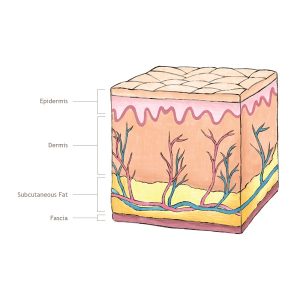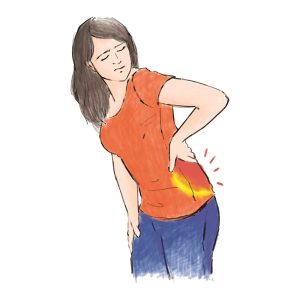A Surprising Source of Your Pain
Do you have scars from past surgeries? Whether a surgery done with a scalpel leaving a scar along the incision or a tiny hole from arthroscopic surgery, there’s more to a scar than meets the eye. Soft tissue is damaged (cut) in such cases, which forms adhesions (scar tissue). Though you may only see a small scar on the surface, the damage can affect layers of tissues beneath, including the fascia.
What is fascia?
Fascia is the web of connective tissue beneath the skin that attaches, stabilizes, encloses, and separates muscles and other internal organs. It connects everything and is therefore one of the most important structures in the body. Fascia can be found immediately beneath the skin, around muscles, groups of muscles, bones, nerves, blood vessels, organs and cells. Fascia is everywhere; it is essentially what holds us together. The fascial system consists of several layers, each characterized by different direction and thickness, which are constantly and jointly working together.
If the fascia is tight and cannot move properly, you can experience various problems in posture, movement and functioning…resulting in pain. Osteopathy focuses on the body’s soft tissues, especially the fascia. Osteopaths are trained to feel and evaluate the fascia and treat it to release tightness and misalignments.

Scar Tissue, Fascia and Pain
When you have a scar–from a C-section, liver surgery, arthroscopic knee surgery, hernia repair, etc.—it’s more likely there’s underlying fascial dysfunction. When the fascia’s structure is altered, its normal function and interaction is lacking. Such fascial dysfunctions constrict and change your movement, as you can imagine when such an important connective tissue is not aligned properly. A physiological alteration in any part of the body will affect, as a result, everything that is covered by the connective sheet.
Therefore, for example, a woman who’s had a C-section might suffer from headaches and low back pain. While it may seem hard to believe the scar on the abdomen would cause such issues in other areas of the body, it is understandable when you look at how the body is connected and how the fascia functions. The changes to the fascia constrict movement which leads to compensations and changes in other areas of the body, which you eventually notice as pain.
Evaluation and Treatment
This is why your osteopath does a full medical history and asks about old surgeries, injuries and scar sites. Combining this history, your description of the problem, and a thorough physical examination, the osteopath can identify issues that may be contributing to your pain. The original issue that may need to be resolved may not be at the site of the pain. The osteopath can then use soft tissue release techniques on the problem areas to help get the body moving and functioning more fully.
Alessandro Ciullo provides a wide range of osteopathic treatments including joint manipulations, muscular, soft tissue, visceral and cranial treatments. He focuses on releasing pain and addressing several functional problems in order to assist the body’s innate healing capacity. Click here to schedule an appointment with him.
